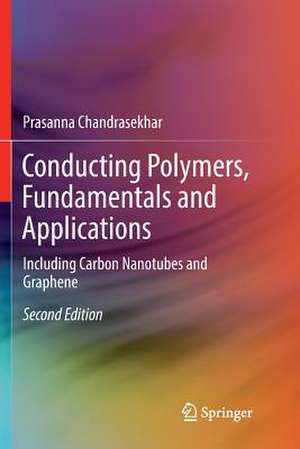Conducting Polymers, Fundamentals and Applications: Including Carbon Nanotubes and Graphene
Autor Prasanna Chandrasekharen Limba Engleză Paperback – 14 feb 2019
The features of this new edition include:
- New and updated chapters on novel concepts in conducting polymers
- Details on interdisciplinary applications of conducting polymers
| Toate formatele și edițiile | Preț | Express |
|---|---|---|
| Paperback (1) | 610.61 lei 6-8 săpt. | |
| Springer International Publishing – 14 feb 2019 | 610.61 lei 6-8 săpt. | |
| Hardback (1) | 758.90 lei 6-8 săpt. | |
| Springer International Publishing – 12 mar 2018 | 758.90 lei 6-8 săpt. |
Preț: 610.61 lei
Preț vechi: 718.36 lei
-15% Nou
Puncte Express: 916
Preț estimativ în valută:
116.85€ • 121.30$ • 97.44£
116.85€ • 121.30$ • 97.44£
Carte tipărită la comandă
Livrare economică 25 martie-08 aprilie
Preluare comenzi: 021 569.72.76
Specificații
ISBN-13: 9783030098858
ISBN-10: 3030098850
Pagini: 810
Ilustrații: XXX, 810 p.
Dimensiuni: 155 x 235 mm
Greutate: 1.16 kg
Ediția:Softcover reprint of the original 2nd ed. 2018
Editura: Springer International Publishing
Colecția Springer
Locul publicării:Cham, Switzerland
ISBN-10: 3030098850
Pagini: 810
Ilustrații: XXX, 810 p.
Dimensiuni: 155 x 235 mm
Greutate: 1.16 kg
Ediția:Softcover reprint of the original 2nd ed. 2018
Editura: Springer International Publishing
Colecția Springer
Locul publicării:Cham, Switzerland
Cuprins
Part I: Carbon Nanotubes (CNTS), Fundamentals.- Introducing Carbon Nanotubes (CNTS).- Conduction Models and Electronic Structure of CNTS.- Synthesis, Purification and Chemical Modification of CNTS.- Physical, Mechanical and Thermal Properties of CNTS.- Toxicology of CNTS.- Part II: Carbon Nanotubes (CNTS), Applications.- Brief, General Overview of Applications.- CNT Applications in Specialized Materials.- CNT Applications in Batteries and Energy Devices.- CNT Applications in Sensors and Actuators.- CNT Applications in Drug and Biomolecule Delivery.- CNT Applications in Microelectronics, “Nanoelectronics” and “Nano-bioelectronics”.- CNT Applications in Displays and Transparent, Conductive Films/Substrates.- CNT Applications in Electrical Conductors, “Quantum Nanowires”, Potential Superconductors.- CNT Applications in the Environment and in Materials Used in Separation Science.- Miscellaneous CNT Applications.- Part III: Graphene, Fundamentals.- Introducing Graphene.- Electronic Structure and Conduction Models of Graphene.- Synthesis and Chemical Modification of Graphene.- Part IV: Graphene, Applications.- Brief, General Overview of Applications.- Graphene Applications in Sensors.- Graphene Applications in Batteries and Energy Devices.- Graphene Applications in Electronics, Electrical Conductors, and Related Uses.- Graphene Applications in Displays and Transparent, Conductive Films/Substrates.- Medical and Pharmaceutical Applications of Graphene.- Graphene Applications in Specialized Materials.- Miscellaneous Applications of Graphene.- Part V: Conducting Polymers, Fundamentals.- Introducting Conducting Polymers (CPS).- Conduction Models and Electronic Structure of CPS.- Basic Electrochromics of CPS.- Basic Electrochemistry of CPS.- Syntheses and Processing of CPS.- Structural Aspects and Morphology of CPS.- Characterization Methods.- Classes of CPS: Part 1.- Classes of CPS: Part 2.- Part VI: Conducting Polymers, Applications.- Sensors.- Batteries and Energy Devices.-Electrochromics.- Displays, Including Light Emitting Diodes (LEDS) and Conductive Films.- Microwave- and Conductivity-based Technologies.- Electro-optic and Optical Devices.- Electrochemomechanical, Chemomechanical and Related Devices.- Miscellaneous Applications.
Recenzii
“The second edition of this popular textbook provides a comprehensive overview on the practical basics and applications of conducting polymers. It fulfills its intension of assisting various researchers from diverse fields to become familiar with fundamentals and applications of conducting polymers.” (Ralph Bäßler, Materials and Corrosion, 2018)
Notă biografică
Prasanna Chandrasekhar received his B.Sc. (Honors) in Chemistry from the University of Delhi, Delhi, India in 1978, his M.Sc. in Inorganic Chemistry/X-Ray-Crystallography from Concordia University, Montréal, Canada in 1980, and his Ph.D. in Electro-analytical Chemistry from the State University of New York (SUNY) at Buffalo, Buffalo, New York, USA in 1984. He was a postdoctoral associate at the Department of Chemistry and Materials Science Center, Cornell University, Ithaca, New York, USA in 1984-5, and a Senior Research Scientist at Honeywell, Inc. in Minneapolis, Minnesota, USA and Horsham, Pennsylvania, USA from 1985-1987. From 1987-1992, he was Manager of Electrochemical Programs at Gumbs Associates, Inc., East Brunswick, New Jersey, USA.
Dr. Chandrasekhar founded Ashwin-Ushas Corporation in October 1992, and has been President, CEO and sole owner there since. Ashwin-Ushas Corporation is a research company active in the defense and aerospace fields that has pioneered technologies based on Conducting Polymers (CPs), including IR-region electrochromics for terrestrial military camouflage, variable-emittance skins for spacecraft thermal control, visible-region electrochromics for safety and sunwear, and, most recently, voltammetric electrochemical sensors for chemical warfare agents. Dr. Chandrasekhar is the author or co-author of over 100 peer-reviewed publications and a large portfolio of worldwide patents.
Dr. Chandrasekhar’s other interests include music, ancient history, archaeology, linguistics and languages. He is the author of NAVLIPI, a universal alphabet published and patented in 2012 and applicable to all the world’s languages. This claims to be the first truly phonemic script in the world. He is also the author of several forthcoming books, including a primer of Sanskrit directed specifically to students of western classical languages (ancient Greek, Latin) and a summary compendium of ancient Hindu philosophy.
Textul de pe ultima copertă
The second edition of this popular textbook thoroughly covers the practical basics and applications of conducting polymers. It also addresses materials that have gained prominence since the first edition of this book was published, namely carbon nanotubes and graphene.
The features of this new edition include:
- New and updated chapters on novel concepts in conducting polymers
- Details on interdisciplinary applications of conducting polymers
- An in depth description of classes of conducting polymers
Caracteristici
Explains in detail the underlying scientific principles of conducting polymers Introduces new concepts and subjects such as polarons, bipolarons, solitons, conduction models, polymerization methods, classes of conducting polymers Covers the full spectrum of new applications of conducting polymers Details, for in depth study, interdisciplinary applications of conducting polymers such as those in conjunction with materials such as carbon nanotubes and graphene Includes informative problems and exercises for coursework at the end of each chapter
